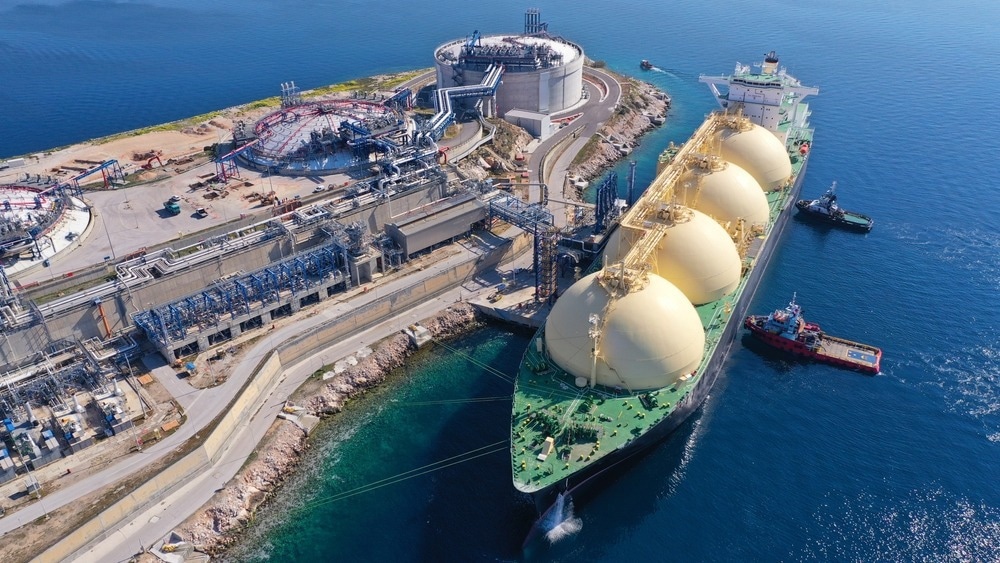Companies seeking to preserve the importance of natural gas in the energy transition are embracing carbon-free liquefied natural gas (LNG). This rapidly expanding market allows buyers and sellers to offset greenhouse gas emissions from LNG shipments. However, carbon-neutral LNG trading still lacks consistency and transparency, and it is a marginal solution to the LNG industry's emissions.

Image Credit: Aerial-motion/Shutterstock.com
What is Carbon-Neutral LNG?
Liquefied Natural Gas (LNG) is natural gas that has been converted to a liquid state at a temperature of -160 °C. When compared to other fossil fuels such as petroleum, LNG provides significant emission reductions. According to the Oxford Energy Institute, LNG's global average emissions intensity is 0.35 percent carbon dioxide (CO2) per ton.
Natural gas consists of 85-95 percent methane, which is formed of one carbon atom and four hydrogen atoms (CH4). Carbon is an inherent component of LNG; hence it cannot be free of carbon or emissions.
Carbon-neutral LNG refers to purchasing carbon credits to offset emissions from the LNG supply chains. Carbon credits can be used to fund various offset projects, including reforestation, afforestation, and renewable energy projects.
Some of these projects help the environment by removing carbon from the atmosphere and canceling out the LNG cargo's emissions. However, other projects, such as large-scale wind and solar installations, prevent an increase in emissions rather than reducing them.
Which Emissions From the LNG Supply Chain Need to be Offset?
Carbon neutrality can only be achieved by offsetting lifetime emissions, including all emissions connected with LNG's manufacture, transportation, and consumption.
The Greenhouse Gas Protocol divides and measures greenhouse gas (GHG) emissions throughout a lifespan into the following three categories:
- Scope 1 emissions: greenhouse gas emissions that are directly released from company-controlled operations
- Scope 2 emissions: An organization's indirect greenhouse gas emissions resulting from the production of energy purchased or obtained (electricity, steam, heating, cooling)
- Scope 3 emissions: all the indirect downstream and upstream value chain emissions of a company
Current Situation of the Carbon-Neutral LNG Trade
Carbon-neutral liquefied natural gas (LNG) has arisen as an innovative means of reducing the environmental impact of natural gas sales. As the globe embraces sustainable energy, oil and gas companies and consumers are intensifying their efforts to lessen their carbon footprint and move towards carbon-neutral LNG.
The majority of LNG buyers are in Asia, where natural gas is imported to replace coal in power generation.
In 2019, GS Energy and Tokyo Gas purchased a carbon-neutral LNG cargo from Shell, making it the first carbon-neutral LNG cargo traded. The vendor agreed to remove carbon emissions from the entire LNG value chain, which included Scopes 1, 2, and 3.
Since then, numerous energy companies have announced new agreements with varying terms, such as partial offsets of certain operations, such as end-user combustion rather than lifecycle offsets. The buyers' needs and the seller's capabilities dictate the choice to trade a lifetime or partial carbon-neutral LNG transaction.
The natural gas trading market is subject to environmental scrutiny from investors, regulators, and capital-providing lenders. Making carbon-neutral LNG cargoes is an attractive method to alleviate these worries.
Unsatisfactory Form of Clean Energy
The most problematic component of carbon-neutral LNG is how carbon credits are obtained to offset emissions. There is currently no government or authorized organization monitoring to ensure that the stated carbon savings are delivered.
Several organizations run registries where businesses can buy carbon credits. While some of these registers are run by reputable and trustworthy standard-setting organizations such as the Gold Standard, others use less severe assessments and may sell offset projects that do not meet particular characteristics or environmental standards.
For example, some companies have chosen low-cost offsets from projects that assist brush clearing or tree preservation – and while these projects do reduce emissions, there is a small amount of carbon removed from the atmosphere. Because the true effectiveness of these carbon offsets cannot be determined with certainty, calculating and assessing their worth becomes difficult.
Several carbon-neutral LNG trades have been scrutinized because the carbon-neutral label on these transactions only applies to scope 1 and 2 emissions, which are emissions created during LNG production's extraction and liquefaction processes. However, they do not compensate for the more substantial scope 3 emissions, which occur when gas is burned by consumers and accounts for roughly 70% of the entire carbon footprint.
Cost is an additional barrier to the widespread adoption of carbon-free LNG. Carbon-neutral cargo can significantly increase the import bill of an LNG purchaser.
The Future of Carbon Neutral LNG
The market for carbon-free LNG is still in its early stages. Its success will require a foundation of globally accepted standards based on best practices in emissions estimation and offsets.
The carbon-neutral LNG market will improve over time if the industry is willing to adapt to updated policies and maintains a high level of transparency.
As the need for LNG grows, so will the demand for carbon-neutral LNG. Future legislation, shareholder requirements, and project financing terms will likely mandate that all LNG cargoes include extensive information about the carbon emissions associated with their production and delivery.
References and Further Reading
Blanton, E., & Mosis, S. (2021). The Carbon-Neutral LNG Market: Creating a Framework for Real Emissions Reductions. Available from: https://www.energypolicy.columbia.edu/
Cahill, B. (2022). Credibility Gap for Carbon-Neutral LNG. [Online]. Available at: https://www.csis.org/analysis/credibility-gap-carbon-neutral-lng (Accessed on 18 May 2022)
Oxford Analytica. (2021). LNG producers will aim to cut their carbon footprint. Emerald Expert Briefings, (oxan-db). https://doi.org/10.1108/OXAN-DB261130
Urn, L., & Chua, J. (2021). "Carbon-neutral" LNG - A permanent strategy, or a fleeting trend? [Online]. Available at: https://www.argusmedia.com/en/blog/2021/november/23/carbon-neutral-lng-a-permanent-strategy-or-a-fleeting-trend (Accessed on 18 May 2022)
Disclaimer: The views expressed here are those of the author expressed in their private capacity and do not necessarily represent the views of AZoM.com Limited T/A AZoNetwork the owner and operator of this website. This disclaimer forms part of the Terms and conditions of use of this website.